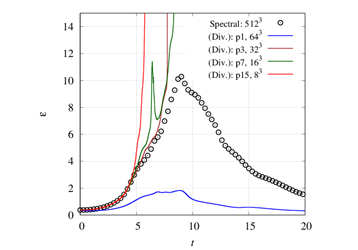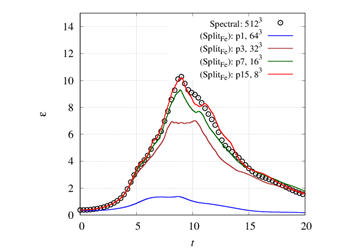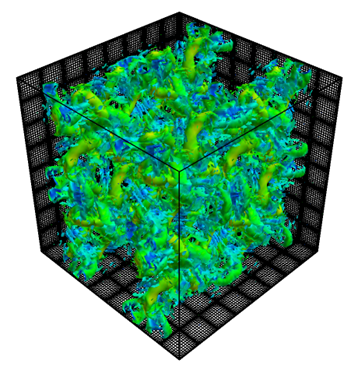Stabilization of high-order flux-reconstruction schemes with split forms
JAXA Supercomputer System Annual Report April 2016-March 2017
Report Number: R16E0056
- Responsible Representative: Yoshiaki Abe(Department of Mechanical Engineering, Tokyo Institute of Technology)
- Contact Information: Yoshiaki Abe(y.abe@imperial.ac.uk)
- Members: Yoshiaki Abe
- Subject Category: Basic Research(Numerical analysis,CFD)
Abstract
We have investigated a coupling of very-high-order flux-reconstruction scheme and kinetic energy preserving framework for simulating high-Reynolds-number flows around complex geometries using parallel computers. Several numerical experiments have been conducted for isotropic turbulence without excessive numerical dissipation.
Goal
This project focuses on a development of numerical methodologies for high-fidelity flow simulations on a next generation computational architecture aiming at a novel approach for designing fluid machineries under high-Reynolds-number conditions such as aerospace vehicles.
Objective
The objective of this project is the development of a stable very-high-order unstructured schemes using flux-reconstruction and kinetic energy preserving framework.
References and Links
N/A
Use of the Supercomputer
The proposed flux-reconstruction scheme with a kinetic preserving framework has been investigated from its nonlinear stability aspects, where a wide variety of spatial accuracy has been examined for isotropic turbulence. Excessive parametric studies have been doable in short term owing to the use of the super computer.
Necessity of the Supercomputer
The current project is based on the flux-reconstruction scheme, which is well known as a highly cost-effective method on parallel computers. Therefore, these schemes should be carefully developed even in its early stage of algorithm discussion and code implementation although the present study mainly investigate a very basic aspect of numerical schemes.
Achievements of the Year
The present study focuses on an investigation of stable framework for very-high-order flux-reconstruction scheme. For this purpose, we have attempted to apply a kinetic energy preserving framework for the flux-reconstruction scheme, which has been recognized as one of the most feasible nonlinear stabilization techniques in high-order CFD community. The investigation using a polynomial expansion reveals the following two sufficient conditions: the solution points must be located at Gauss-Lobatto points; and the correction function must be the g2 function. A number of numerical tests has been carried out for the verification of this framework, where the Taylor-Green vortex problem has been solved. The parameters such as spatial accuracy and numerical dissipation have been extensively studied through these tests.
Figure 1 shows the result of a conventional FR scheme for the Taylor-Green vortex (Re=1,600) with the total number of DoF (degree of freedom) being fixed to 128^3. The normal FR framework is numerically unstable at fourth-order of accuracy (p3) and greater in Fig.1, whilst, surprisingly in Fig.2, the newly proposed kinetic energy preserving FR framework is stable even at sixteenth-order accuracy (p15). Figure 3 shows isosurfaces of the vorticity, where the flow field can be appropriately represented by very-high-order polynomials in each cell.
Note that we have also confirmed that the present framework works well even with a nondissipative flux, e.g., KEP flux, for the inviscid flux term. Therefore, the present scheme enables a stable framework such that the nonlinear stability can be maintained without excessive numerical dissipation.

Fig.1:Temporal evolution of dissipation rate based on the enstrophy in Taylor-Green vortex using a divergence form of FR scheme

Fig.2:Temporal evolution of dissipation rate based on the enstrophy in Taylor-Green vortex using new split form of FR scheme

Fig.3:Instantaneous isosurfaces of vorticity in Taylor-Green vortex using new split form of FR scheme with sixteenth-order accuracy
Publications
Peer-reviewed articles
1)(under review)Stable, non-dissipative, and conservative flux-reconstruction schemes in split forms,submitted to Journal of Computational Physics, 2017
Presentations
1)Yoshiaki Abe, Issei Morinaka, Takanori Haga, Taku Nonomura, Koji Miyaji, Flux reconstruction scheme in split form, 4th international workshop for high-order CFD methods, Greece, June, 2017
2)Issei Morinaka, Yoshiaki Abe, Takanori Haga, Taku Nonomura, Koji Miyaji, Conservation Properties of High-order Flux-reconstruction Scheme in Split Forms, ECCOMAS Congress 2016, June, Crete, Greece
Computational Information
- Parallelization Methods: Thread Parallelization
- Process Parallelization Methods: n/a
- Thread Parallelization Methods: OpenMP
- Number of Processes: 1
- Number of Threads per Process: 16
- Number of Nodes Used: 1
- Elapsed Time per Case (Hours): 24
- Number of Cases: 32
Resources Used
Total Amount of Virtual Cost(Yen): 135,581
Breakdown List by Resources
| System Name | Amount of Core Time(core x hours) | Virtual Cost(Yen) |
|---|---|---|
| SORA-MA | 72,288.08 | 118,895 |
| SORA-PP | 0.00 | 0 |
| SORA-LM | 0.00 | 0 |
| SORA-TPP | 0.00 | 0 |
| File System Name | Storage assigned(GiB) | Virtual Cost(Yen) |
|---|---|---|
| /home | 39.74 | 251 |
| /data | 1,627.60 | 10,320 |
| /ltmp | 162.76 | 1,032 |
| Archiving System Name | Storage used(TiB) | Virtual Cost(Yen) |
|---|---|---|
| J-SPACE | 2.45 | 5,080 |
Note: Virtual Cost=amount of cost, using the unit price list of JAXA Facility Utilization program(2016)
JAXA Supercomputer System Annual Report April 2016-March 2017


